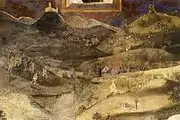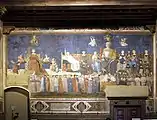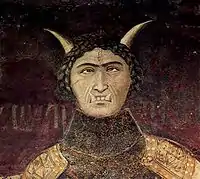好政府与坏政府的寓言
《好政府与坏政府的寓言》(The Allegory of Good and Bad Government)是安布羅喬·洛倫澤蒂(Ambrogio Lorenzetti)的三幅系列壁画,绘于1338年2月至1339年5月,位于意大利锡耶纳市政厅的九人大厅(Sala dei Nove),锡耶纳共和国履行行政职能和司法职能的九人集团的议会大厅[1]。这些画作被解释为“旨在提醒九位执政官在做决定时,有多么处于危险之中”[2]。
| 好政府与坏政府的寓言 | |
|---|---|
_-_WGA13487.jpg.webp) | |
| 年份 | 1338 |
| 主題 | 好政府与坏政府的寓言 |
| 收藏地 | 意大利锡耶纳锡耶纳市政厅 |
| 藏主 | Fondazione Musei Senesi |

该系列被认为是洛伦泽蒂的"无可争议的杰作",[3] 由六个不同的场景组成:
- 《好政府的寓言》
- 《坏政府的寓言》
- 《城市坏政府的影响》
- 《国家坏政府的影响》
- 《城市好政府的影响》
- 《国家好政府的影响》
历史背景
《好政府与坏政府的寓言和影响》系列是由九人集团(市议会)委托。[4] 与当时大多数艺术不同,它的主题是世俗而不是宗教。锡耶纳共和国是14世纪意大利最强大的城邦之一,一个城市中心,充满了银行家和商人,有许多国际联系。14世纪是意大利城市政治的动荡时期,由于不断的暴力政党斗争,政府忽而被推翻,忽而又被恢复。
布局
壁画占据了大量的空间,覆盖了会议厅四面墙中的三面。唯一没有壁画的墙是南墙,因为这堵墙上有房间的唯一的窗户。进门以后就看到对面的北墙。洛伦泽蒂在东墙,描绘了《好政府的影响》的场景,而在对面的西墙,描绘了"坏政府的影响"。在北墙上则是好政府美德的寓言。
 《国家坏政府的影响》
《国家坏政府的影响》 《城市坏政府的影响》
《城市坏政府的影响》 《坏政府的寓言》
《坏政府的寓言》 《好政府的寓言》
《好政府的寓言》 《城市好政府的影响》
《城市好政府的影响》 《国家好政府的影响》
《国家好政府的影响》
《好政府的寓言》

在《好政府的寓言》中,构图包括三个水平带。前景代表当代锡耶纳的人物。公民代表充当各种民政官和裁判官。他们被正义女神下收集的绳子联系在一起。在他们身后,在舞台上,有两组寓言人物,代表好政府。两组人物由议员的队伍组成。上带代表天堂。智慧坐在锡耶纳城市化身的头顶之上。他坐在宝座上,手里拿着十字圣球和权杖,象征着力量。他的衣着颜色是锡耶纳紋章的黑白相间。他的头上有四个字母"C S C V"(Commune Saenorum Civitatis Virginis),这解释了他的身份为锡耶纳理事会的化身 。这个人物以信、望、愛为指导。

好政府的美德由六位加冕的女性人物代表:左边是和平、勇氣和审慎,右边是慷慨、节制和正义。在壁画的最左边,正义人物的身影被重复,因为她正在平衡智慧。这些女性形象代表了锡耶纳女性美的理想。在她的脚下是两个孩子在玩。他们可能是雷穆斯、阿斯丘斯和塞尼乌斯的儿子,根据罗马神话,他们是锡耶纳的创始人。还有人认为,这两个孩子就是罗慕路斯与雷穆斯本人,他们创建了罗马。
壁画下方是洛伦泽蒂的签名:西恩納的安布羅西奧斯·洛朗蒂畫了此作與另一件(Ambrosius Laurentii De Senis Hic Pinxit Utrinque)[5]。
《好政府的影响》

《坏政府的寓言》



参考
- Polzer, Joseph. . Artibus et Historiae. 45. 2002, 23: 64. doi:10.2307/1483682.
- Ferguson, Niall. . Penguin Press. 2017: 425–431. ISBN 978-0735222915.
- . Google Arts & Culture. [28 January 2018].
- "Prelude to the Renaissance: Florence and Siena in the 14th century" 的存檔,存档日期2011-07-20., radford.edu.
- . www.wga.hu. [2020-10-06]. (原始内容存档于2016-03-04).
延伸阅读
- Jollingsworth, Mary. Art in World History. N.P. 2004
- Janson, H.W. & Anthony F. History of Art. New York, NY. 1997.
- Rogers, Ray. Art: A World History. London, UK. 1998.
- “The Allegory of Good and Bad Government in Siena.” Tuscany Arts: See Beyond the Visual. February 18, 2011 <http://www.turismo.intoscana.it/allthingstuscany/tuscanyarts/allegory-good-bad-government-siena/ 页面存档备份,存于>
- “Sienese Followers of Duccio: Ambrogio and Pietro Lorenzetti.” February 26, 2011. <http://employees.oneonta.edu/farberas/arth/arth213/lorenzetti.html 页面存档备份,存于>
- Kren, Emil, and Marx, Daniel. “Lorenzetti, Amrbrogio : The Allegory of Good Government.” Web Gallery of Art. Web Gallery of Art. February 16, 2011. <http://www.wga.hu/frames-e.html?/html/l/lorenzet/ambrogio/governme/1good1.html 页面存档备份,存于>
- Campbell, C. Jean. "The City's New CLothes: Ambrogio Lornzetti and the Poetics of Peace." The Art Bulletin 83.2 (2001): 240-58. Print.
- Frugoni, Chiara. "The Book of Wisdom and Lorenzetti's Fresco in the Palazzo Pubblico at Siena." Journal of the Warburg and Courtauld Institute 43 (1980): 239-41. Print.
- Greenstein, Jack M. "The Vision of Peace: Meaning and Representation in Ambrogio Lorenzetti's Sala Della Pace Cityscapes." Art History 11.4 (1988): 492-510. Print.
- Polzer, Joseph. "Ambrogio Lorenzetti's "War and Peace" Murals Revisited; Contributions to the Meaning of the "Good Government Allegory"" Artibus Et Historiae 23.45 (2002): 63-105.
- Skinner, Quentin. "Ambrogio Lorenzetti's Buon Governo Frescoes: Two Old Questions, Two New Answers." Journal of the Warburg and Courtauld Institute 62 (1999): 1-28.
- Silvestri, Paolo, "After-word. Invisible Cities: Which (good-bad) man? For which (good-bad) polity?", in P. Heritier, P. Silvestri (eds.), Good government, Governance and Human Complexity. Luigi Einaudi's Legacy and Contemporary Society, Leo Olschki, Firenze, 2012, pp. 313–332. https://ideas.repec.org/p/pra/mprapa/59535.html 页面存档备份,存于
- Hyman, Timothy. Sienese Painting: The Art of a City-republic (1278–1477). New York, NY: Thames & Hudson, 2003. Print.
- Carli, Enzo. Sienese Painting. (Greenwich, CT: New York Graphic Society, 1956).
- Burke, Suzanne Maureen, Ambrogio Lorenzetti's Sala della Pace: Its Historiography and "Sensus Astrologicus", Ph.D. diss., New York University, 1994
- Cole, Bruce. Sienese Painting in the Age of the Renaissance. (Bloomington: Indiana UP, 1985).
外部連結
- . Smarthistory at Khan Academy. [January 25, 2013]. (原始内容存档于2014-10-27).